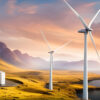The electrical energy sector faces ongoing challenges in transporting power from generation sources to areas of high consumption due to constraints of the transmission grid infrastructure and associated permitting processes. As power demand continues rising globally and supply shifts toward renewable resources located farther from load centres, these issues have become increasingly prominent. If left unaddressed, grid congestion and permitting barriers could undermine reliability and affordability goals within the industry. This article analyses ongoing technical and policy efforts seeking to modernize grid infrastructure and streamline permitting reviews to help accommodate emerging energy realities.
Transmission Congestion
Transmission lines essentially function as the highways, enabling power to flow from generators to customers. However, when generation and load patterns diverge or transmission capacity fails to keep pace with rising electricity usage, grid congestion may ensue. Technical congestion refers to the inability to physically transport the lowest-cost power to end users due to insufficient transmission line capacity. Economic congestion describes when transmission limitations cause electricity to be sourced from higher-cost generation units in some areas instead of less expensive alternatives elsewhere.
Both types of congestion introduce inefficiencies that may ultimately be passed on to ratepayers. Studies have attempted to quantify these costs, with one 2020 report estimating that transmission congestion led to over $7 billion in additional annual generation costs in the United States alone. Congestion levels also fluctuate depending on generation and demand patterns at a given time. Peak loads during summer months tend to exacerbate constraints.
Grid modernization aims to both harden physical transmission infrastructure and enhance operational controls to manage flows more effectively in real-time. On the hardware side, projects are progressing to upgrade transmission lines as well as incorporate technologies like dynamic line rating systems, phase-shifting transformers, and high-voltage direct current lines. These solutions complement traditional grid expansions. Sophisticated modelling also supports more optimal preventative and corrective congestion management practices through generation re-dispatch, demand response, and other scheduling adjustments.

Grid Planning and Permitting Process
While technical options exist to expand bulk power transmission, the planning and permitting process governing new line approvals has emerged as a substantial policy barrier. Assessing potential routes, conducting environmental reviews, obtaining necessary permits, and addressing public concerns can often take a decade or more per project. Lengthy delays undermine the ability to effectively and economically address congestion before it escalates significantly.
The proposed transmission also faces local opposition wary of perceived negative impacts on property values, aesthetics, and the environment. However, delaying critical upgrades may ultimately increase emissions if it continues relying on older, less efficient generation resources hampered by transmission limitations. Environmental reviews already conducted for approved lines could also become outdated if the process stretches too long.
Policy reforms seek to streamline permitting without compromising environmental protections or public participation. Steps include establishing regional planning processes to identify priority projects, harmonizing requirements between multiple agencies, setting defined schedules and deadlines, and increasing coordination between federal and state authorities. Some jurisdictions have granted one-stop-shopping approvals while still addressing all relevant issues. Early and meaningful public engagement also builds understanding of need.
Evolution of Generation and Load Patterns
A compounding factor influencing grid requirements involves the ongoing evolution of power supply and demand centres. Generation is increasingly migrating toward renewable resources such as solar and wind facilities located away from cities. Weather-dependent power also exhibits variable and less predictable output patterns that challenge traditional grid operations designed around steady central baseload plants.
Meanwhile, load centres themselves may decentralize as distributed energy resources (DER) including rooftop solar, microgrids, electric vehicles, and demand response become more widespread. Two-way power flows will require greater visibility, control, and integration capabilities. Retiring fossil fuel plants also alter generation patterns, as do policies like carbon pricing that may suppress certain types of development. Flexible resources able to support intermittent renewable energy will grow in strategic importance.
Numerous technical solutions exist to help accommodate these shifts and maintain reliability as the resource mix changes. Enhanced monitoring and advanced control systems can optimize variable supply and demand across high-voltage, transmission and local distribution systems. Energy storage, demand response aggregation, and other distributed flexibility options complement transmission and generation investments. Coupling smart infrastructure with proactive planning helps ensure a smooth transition toward clean energy goals.
Regulatory and Market Reforms
Beyond physical upgrades, regulatory and market reforms assist in maximizing available transmission capability. Transmission owners historically recovered approved costs through regulated rates, which disincentivized expansions not assured immediate revenues. Reforms transition approved lines to participate in competitive wholesale markets through participant funding or regional cost allocation.
Enhanced regional coordination supports more holistic planning beyond individual utility footprints. Coordinated interregional planning considers multi-state needs and benefits. Market mechanisms like redispatch further optimize congestion relief. Performance-based ratemaking ties transmission returns not just to construction quality but system performance over time. Earlier cost recovery for approved lines addresses risk barriers.
These policies work in tandem with infrastructure investments. By establishing more efficient transmission cost allocation and compensating operators for congestion management services, market and regulatory drivers help properly value lines for supporting competitive electricity trade. Regional systems ensure affordability through socializing savings across broader areas.
Takeaway
Continued progress on both technical grid modernization and streamlining permitting and regulatory processes remains important for maintaining a reliable and cost-effective transition toward competitive clean energy goals. Transmission planning should align with generation shift timelines to avoid congestion in already strained networks. Synchronized national and regional coordination helps address multi-jurisdictional issues. Standardizing reviews and optimizing schedules encourages critically needed projects while preserving stakeholder input. Competitive wholesale energy markets properly internalize transmission value through participant funding and cost allocation, ensuring performance incentives that incorporate both reliability and efficiency.
At CLOU, our advanced metering and energy storage solutions play a pivotal role in supporting these initiatives. By providing precise data and enhancing grid reliability, our products help industry regulators and operators confidently manage the complexities of emerging systems and the growth in electricity demand.
If you have any inquiries or need further information about our metering and energy storage solutions, please do not hesitate to reach out to us. We are here to assist you.
Thank you for reading. If you would like to share your thoughts on this topic, please feel free to leave a comment below.
Until then, keep shining bright like a solar panel on a sunny day!






All comments are moderated before being published. Inappropriate or off-topic comments may not be approved.